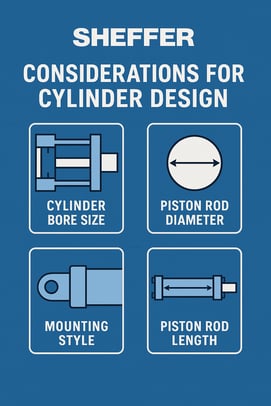When designing a cylinder, it is important to consider how much force will be on the piston rod as the cylinder is extending. If too much compressive force is applied to the piston rod in extend, it will cause it to bend and buckle. Consider a coffee stirrer. When placed between two fingers and pushed on, it very easily bends. Now consider a drinking straw. While it might be longer, it also has a larger diameter, thus when placed between two fingers and pushed on with the same amount of force it does not bend as easily. In the same way piston rods will bend when the force to rod diameter ratio becomes too large. Several factors contribute to the force, and associated cylinder pressure, when this bending will begin to occur. These factors include bore size, rod diameter, mounting style, length of stroke and extra plain rod extension, and even rod material.
The Cylinder bore size will dictate how much force is available to push on the piston rod. If that force is higher than the force necessary to bend the piston rod, the pressure rating on the extend stroke will have to be lowered, or de-rated, to achieve a force that will not risk bending the piston rod.
The Piston Rod diameter is a critical component in calculating how much force the piston rod can withstand prior to bending. When we considered the coffee stirrer and the drinking straw, the drinking straw did not bend as easily as the coffee stirrer because of the larger diameter of the drinking straw. Simply put, the larger the diameter of the piston rod the more force it can withstand prior to bending. In many cases a cylinder designer should consider a larger piston rod if the extend pressure is de-rated lower than required for the application.
Mounting style, although not easily changed due to design requirements, can have a big impact on when the piston rod will reach the critical load prior to buckling. Consider our coffee stirrer, by simply pushing on both ends of the stirrer it bends easily, but if both ends are gripped and then pushed on it does not bend as easily. In the same way a cylinder piston rod has the same effect. A cylinder that has a clevis mount is subject to more bending than a cylinder with a fixed mount such as a Front Head Flange mount that does not move. Sheffer considers six different mounting classes when looking into column strength. 
The Piston rod length is important to consider when looking at the column strength of the piston rod. The piston rod length includes not only the stroke, but any extra plain rod extension as well. Simply put, the longer the piston rod, the less force it can resist. Sheffer has put force ratings for all of its piston rod sizes at varying stroke lengths into an easy to read chart, available on our website.
One other consideration when looking at column strength is piston rod material. Stainless steel piston rods will be less resistant to buckling than standard steel piston rods. This is due to stainless steel’s lower modulus of elasticity. The modulus of elasticity measures a material’s resistance to deformation. For the purposes of calculating column strength of a piston rod, varying grades of steel are similar to one another, and varying grades of stainless steels are similar to one another.
It is important to note that while the cylinder’s extend pressure may be limited based on column strength limitations, this de-rated pressure does not limit the retract pressure of the cylinder.
For cylinders with long strokes and small diameter piston rods, column strength is a very real concern. Even if excessive buckling force does not cause a piston rod to bend and break, the long term effects of excessive compressive force on a piston rod can cause damage to other parts of the cylinder including the piston, piston rod and seals.
Ready to ensure your next cylinder is engineered for maximum strength and reliability?
Download Sheffer’s Ultimate Cylinder Design Checklist or start a build with our Custom Cylinder Configurator at Sheffercorp.com.
